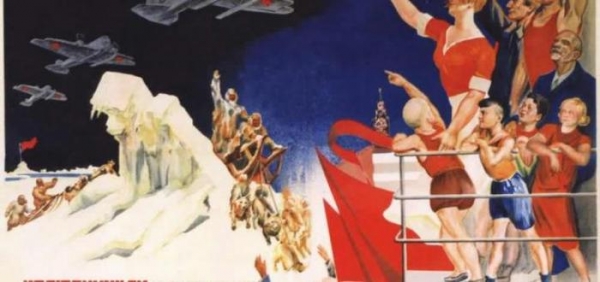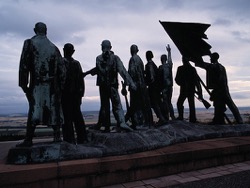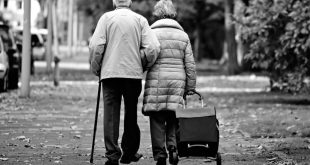
In the previous chapters has been done in understanding the path that was the theory of socialism from primitive concepts through the utopian socialist theory and its practical implementation. When evaluating this path, and having a practice of socialism in the Soviet Union under Lenin and Stalin, we can imagine General principles of socialism. Define what socialism is and what are the further development of the future Communist socio-economic formation.
In the author’s opinion, socialism is neither an independent socio-economic structure, nor part of the Communist formation. Independent socio-economic formation it is not because in contrast to other socio-economic formations socialism can not be practically implemented outside the framework of other socio-economic formations. Nevertheless, he keeps at a certain stage of the trend the old bourgeois economic system. Each new socio-economic system changes only to the owner, the form of ownership has remained the same – private ownership of the means of production. As we can see from the history in the slave society the feudal originated by private teams of supervisors from major slaveholders partial emancipation of the slaves and turning them into so-called Coloni (serfs); in a feudal society is the formation of cities as centers of crafts, trade and banking with the right to exemption of farmers from serfdom (Magdeburg law). Socialism is not change of the owner, and the form of ownership, by the nationalization of private property by the dictatorship of the proletariat and its transformation into property of the whole people.
As noted earlier, Marx said:
“Between capitalist and Communist society lies the period of revolutionary transformation of the first into the second. This period corresponds to the political transition, and the state of this period can be nothing else but the revolutionary dictatorship of the proletariat”.
– G. K. Marx, “Critique of the Gotha program”.
So it turns out that between capitalism and communism lies a certain transition period. Due to the fact that Marx never had the opportunity to test their theoretical development, in practice, he did not distinguish between socialism and communism, but communism was broken into phases: lower and higher. Practice of socialism in the USSR showed that it was completely different periods of development. Socialism may not be communism, because in it, as in the transition period, there are future trends like the Communist socio-economic formation (public ownership of the means of production, absence of exploitation of man by man), and capitalist (commodity-money relations, the classes, the contradictions, the existence of the state). You should see the following: socialism is not built socialism proclaims. Acts proclaimed the abolition of private ownership of the means of production and prior to that enforced elimination of the bourgeois social-economic formation by the elimination of the bourgeois state and all its institutions. After the elimination of bourgeois social-economic formation, which is possible in one country where the link in the chain of capitalist production is the weakest – begins the construction of a Communist society through the solution of a triune task:
1. Education of the new man
2. The determination of the direction of scientific and technical progress on the basis of the planned economy
3. The construction of material and technical basis of Communist society
In order to understand the essence of socialism as the transition period, it is necessary to consider the available it both Communist and capitalist tendencies. Socialism may come to communism only when the tendencies of a Communist society it is encouraged and capitalist suppressed. If the opposite happens, socialism will inevitably return to capitalism, which is what happened in the USSR.
CHAPTER 1
Communist tendencies in socialism.
The proletarian revolution under the slogan of the abolition of private ownership of the means of production and the emancipation of labor from the power of capital. Therefore, it is necessary to completely eliminate private ownership of the means of production through nationalization of all sectors of the economy and its transfer into public property. The management of the property, control over it, its development, and equitable distribution of food production is a function of the newly established proletarian state. The proletarian state is one of the institutions of the dictatorship of the proletariat. This form of the dictatorship of the proletariat is Soviet power, organized in the form of elected bodies on the basis of bringing in these bodies of representatives of the previously exploited class, and to avoid these bodies of representatives of the exploiting classes or their former servants. The Soviet government must be formed by delegation from the lower councils to the higher education and on this basis the Supreme Council.
The Supreme Council constitutes the Executive structure of the state: from the Central Executive Committee to the Executive committees of the grassroots level. The Central Executive Committee forms the government, which is responsible for the permanent management, development and control of the state’s economy. The government formed by the social consumption funds, which receives all produced economy product, which is subsequently distributed for further development of the socialist economy and equally for the population of the whole country.
The Foundation of the socialist economy is socialist production, not based on profit performance and profitability of individual enterprises, and the reduction of production costs and increasing productivity. The basic law of a socialist economy according to Stalin:
“the maximum satisfaction of the constantly growing material and cultural needs of society through the continuous expansion and perfection of socialist production on the basis of higher techniques.”
– I. V. Stalin, “Economic problems of socialism in the USSR”.
Socialist production creates a single national economic complex, which combines the efforts of physical and intellectual. Planned economy allows the use of both human and production resources. The monopoly of foreign trade and the duality of prices which allow to provide inflow to the socialist economy the necessary resources that are temporarily lacking. Public property through socialist production based on the reduction of production costs and increase productivity, allows to constantly increase the content of public consumption funds, which should lead to the abundance of food production and to provide the Communist principle ” from each according to ability to each according to need.
Socialist production eliminates the exploitation of man by man. The profitability from the point of view of individual enterprises and branches of production does not go to any comparison with the highest profitability, which gives the socialist production. Because power in the state belongs to the workers and the ownership of the whole people, naturally have no category of surplus labor. Recall that surplus-labor is alienated by the capitalist in their favor, and after the realization of the surplus product and, consequently, of surplus value in the market appropriated by the capitalist in the form of money and sotavlyaet his profit. In the system of socialist production there is only “direct” work, because the whole product of labor in one form or another, is distributed among all the citizens of the socialist state. If productivity of labour under capitalism is a source of profit for the capitalists, while in socialist production, it serves as a means to reduce the number of basic working hours.
As he wrote to Stalin:
“It is necessary, first, to firmly ensure not a mythical “rational organization” of the productive forces and the continuous growth of all social production with a primary growth of production of means of production. The preferential growth of production of means of production is necessary not only because it must provide equipment such as their own enterprises, and enterprises of all other sectors of the economy, but because without it is impossible to carry out expanded production.”
“It is necessary, thirdly, to achieve such cultural growth of society, which would ensure all members of society the all-round development of their physical and mental abilities that members of society have the opportunity to receive education sufficient to become active members of the social development to have the opportunity to freely choose the profession and not be chained for life, because of the existing division of labor, to any one profession.”
– I. V. Stalin, “Economic problems of socialism in the USSR”
Stalin said that you need to do first to reduce the working day at least to 6 and then to 5 hours. Released time must serve to raise the educational and cultural levels of citizens of the socialist state.
Thus, we see Communist tendencies in socialism not only constantly improve the level of the productive forces, but also constantly pull to him the relations of production, allowing to solve successfully the very triune task on which is written a previously.
CHAPTER 2
Capitalist tendencies in socialism.

Commodity-money relations are an inevitable evil, since the level of production does not allow the Declaration of socialism to create an abundance of product in the consumption of public funds. Therefore the socialist state is forced to enter the state of the monetary system in order to meet the individual needs of citizens, as through the purchase of everyday products and process savings for the purchase of durable consumer goods.
In socialist production commodity-money relations do not exist. As we can see from the practice of economy in the Stalin era, and the transfer of the product to pig stage, and its transportation was carried out without a cash flow. Enterprises producing means of production, and some companies that produce consumer products (with no need for direct communication with a shopping network) had Bank accounts. The necessary amount of money for the payment of wages in various branches of the state Bank of the USSR (Savings banks) was on the invoice. All calculations between the enterprises of the single national economic complex was produced either by obtaining the necessary raw materials for the funds tied to the planned indicators, or transfer balance balance between enterprises. We see the action of commodity-money relations in the socialist economy more and more minimized and eventually (after reaching the abundance of the product in consumption of public funds) is completely eliminated.
Moreover, since the socialist economy involves a constant increase in level of applied technology is, in turn, requires increasing educational and intellectual level of the workers servicing this equipment, leading to a blurring of the contradictions between mental and physical labor.
The second trend is the availability of classes.
The proletarian revolution, declaring private property of the means of production the property of the whole people and after its nationalization, it eliminates the exploiting class – the capitalist class. Nevertheless, there remains a very large society of people of small proprietors, who, after the elimination of the capitalist class is converted into an independent class – the class of the petty bourgeoisie. In her hands in the form of personal property remain insignificant small means of production, which allow it to independently produce certain types of products and services. Why is this society of people, which under capitalism was also subject to exploitation by big capital, becomes a separate class? Because, having personal ownership of small individual means of production, he uses the resulting product for profit. Thus, we have on one side the class of the proletariat, using a public property on means of production to obtain a product fully received by the public consumption funds, on the other hand, a class aimed at making a profit from the manufactured product by retailers. For example, in the Soviet Union this class was the peasantry and cooperatives of artisans. In the Soviet Union were two kinds of property – public property and property of co-operative.
In order to go to communism, it is necessary on the one hand, to educate people free from the desire for profits, on the other hand, to translate collective-farm property into property of the whole people. In the Soviet Union, such attempts were carried out. It is the collectivization of agriculture and introduction in agriculture machine and tractor stations (MTS), as an element of socialism. But the collective-farm peasantry as a class the main goal of making a profit. And here machine-tractor stations (MTS) as an element of socialism needed to be developed to the level of the final product – commodity agricultural products. This should have been done by creating around MTS urban infrastructure. With the presence not only of the living conditions of the city, but also into a system of higher education. This would give the opportunity to attract in the city the peasant youth, which, on the basis of socialist ownership would be engaged in the commercial production of agricultural products. This not only would eliminate the class, whose main objective was profit, but to erase the distinction between town and country. Regarding the availability of cooperative cooperatives, aiming also at obtaining a profit, a gradual improvement in the quality of local production infrastructure would allow, later, from the cooperative infrastructure to be abandoned.
Finally, we turn to the third trend – the presence of the state. This question is the most difficult. Marxism-Leninism argues that a Communist socio-economic formation, the state will not exist. But, on the one hand, Communist society can be built in one country because it is possible in this country and to educate the new man, determine and develop necessary directions of scientific and technological progress and build a material and technical basis of Communist society. But it remains a capitalist encirclement. And Communist society must be protected from external threats. Can handle only a Communist state. On the other hand, the presence of a Communist society throughout the Earth are also affected by global threats – natural disasters, environmental problems, and the problems of overpopulation, i.e., it requires some structures that will be required to organize people and resources necessary to work to overcome the above problems. It can be concluded that the presence of such structures, i.e., the presence of some government functions will be needed in the Communist society.
Socialism as a transitional period.
Constantly we hear and read about the necessity of building socialism. We already talked about the fact that socialism is not built socialism proclaims. Socialism proclaims the acts on the elimination of private ownership of the means of production. Then starts the building of communism. To build communism it is necessary to solve a triune task:
1. Education of the new man, which work for the benefit of society will become a necessity of life
2. The definition and development on the basis of the planned economy, the necessary directions of scientific-technical progress.
3. The construction of material and technical basis of Communist society, which allows to move from the principle of “from each according to ability, to each according to his work”, to the principle of “from each according to ability, to each according to his needs.
These tasks are dialectically linked. One cannot exist without the other so they called a triune task. Consider these points in more detail in the next Chapter.








